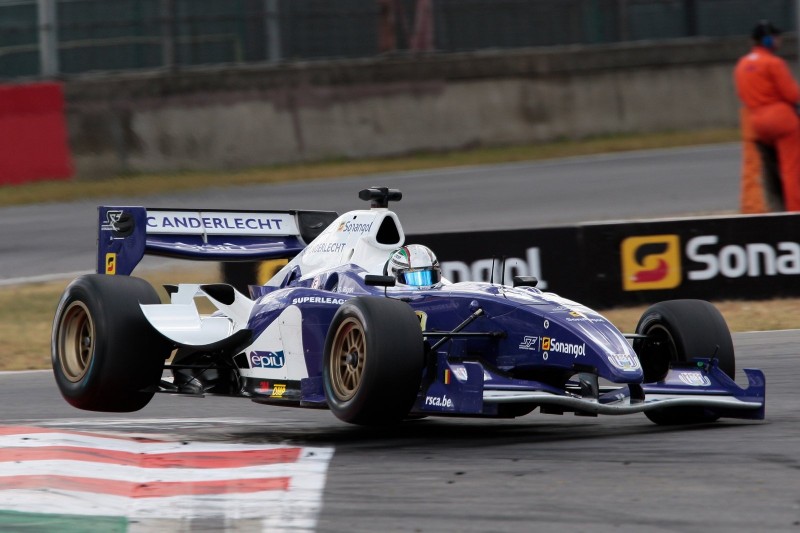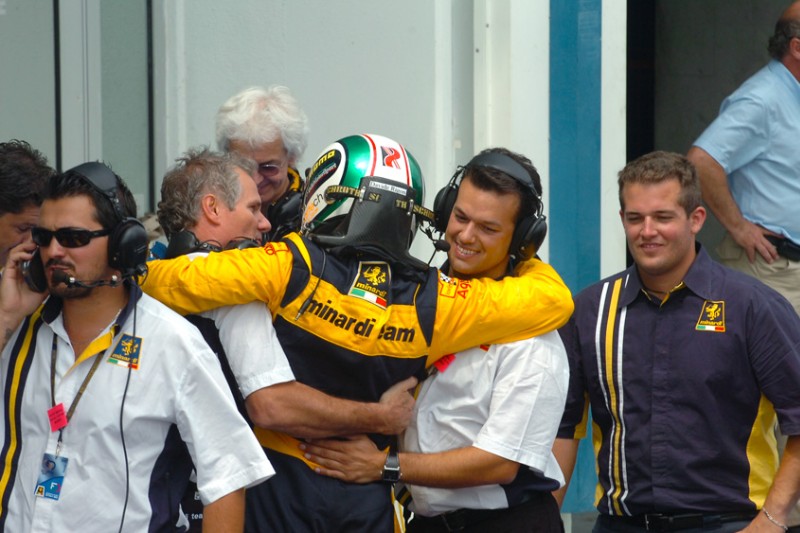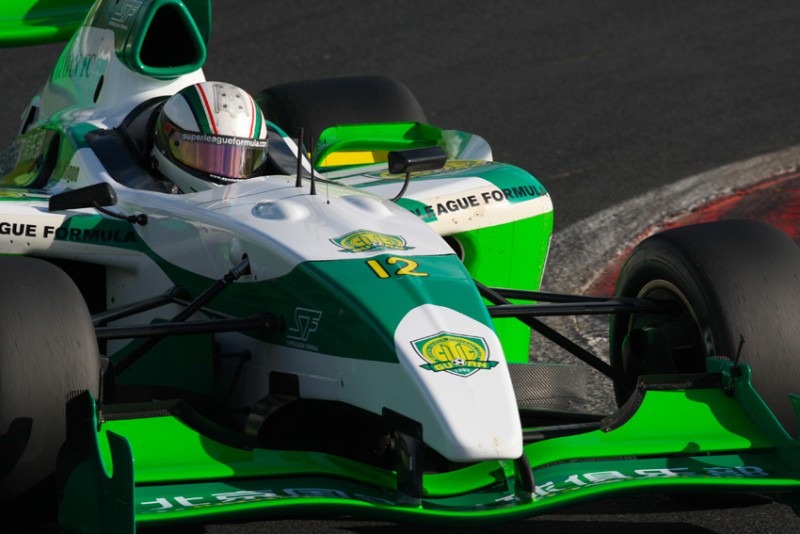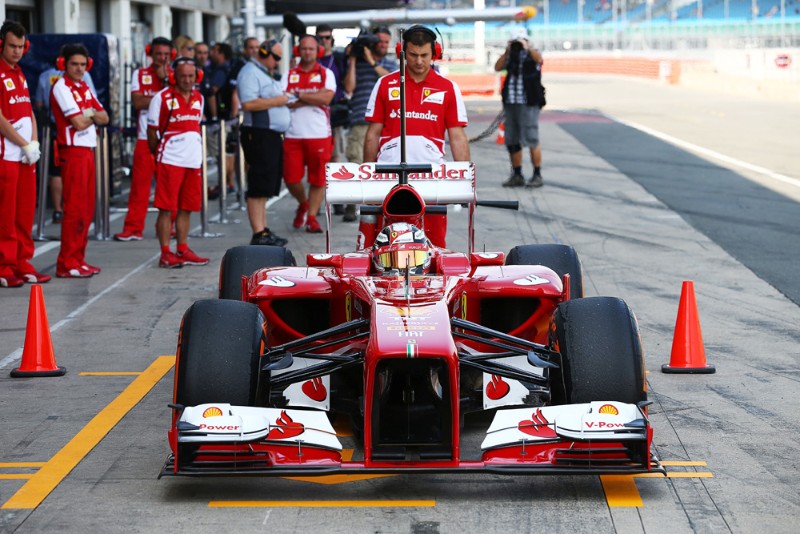
Nine years ago, R.S.C Anderlecht’s Davide Rigon took his second Superleague Formula title. There was no football involved, but it still earned the Italian a full-time transfer to the world’s most famous sport team?
After an underwhelming start to car racing in Formula BMW ADAC, there was little to suggest that one day Davide Rigon would be a crucial member of Ferrari’s Formula 1 team.
“I started in Formula BMW, I did one year in Germany in 2003. Then I went to Formula Abarth, the Italian championship, where I won [in 2005],” Rigon tells Formula Scout.
“Then I moved to Formula Renault, where I won one race in the Italian championship at Misano, it was a mess if you remember. The money was always a problem in my career so I was not able to go in a proper team to win. But luckily I moved to Italian Formula 3 where I had a good result – I was a vice-champion in 2006. Then I moved to Formula 3000.”
Euroseries 3000 (latterly known as Auto GP) used the 3.0-litre V8-powered Lola B02/50, a car that was first utilised in F1’s primary feeder series International F3000 car in 2002. Rigon took a convincing title win as a rookie with the Minardi-backed GP Racing team, and the high-downforce car prepared him well for his next left-field career move.
“[Euroseries] was a big series. It was big power, and I remember without power steering it was very tough. But it was harder because it was where I needed [to be] to become a professional driver; to think about the training and get ready for that car.
“I thought [F1] was realistic at that point. Especially as my manager was Giancarlo Minardi, and I was very close to being the third driver of Toro Rosso at that time. But then Red Bull decided to stop everything that was in the Minardi programme, so I was unlucky a little bit on that side.”
 The uncertainty threw Rigon in the direction of startup series Superleague Formula (SLF) for 2008, which was to use the 4.2L V12 Panoz-MCT. Created by IndyCar specialists, it utilised contemporary F1 technology and was designed with overtaking in mind. The engine was made to be as loud as – and subjectively sound better than – F1, and also helped overtaking in that drivers could select moments to safely over-rev and the high torque unit.
The uncertainty threw Rigon in the direction of startup series Superleague Formula (SLF) for 2008, which was to use the 4.2L V12 Panoz-MCT. Created by IndyCar specialists, it utilised contemporary F1 technology and was designed with overtaking in mind. The engine was made to be as loud as – and subjectively sound better than – F1, and also helped overtaking in that drivers could select moments to safely over-rev and the high torque unit.
Qualifying set the grid for the first race of each weekend, the result of which was reversed to set the grid for race two, supposedly mimicking how football matches have halves. The football-inspired series also introduced penalty shootout-inspired ‘Super Final’ races for the top six points scorers over the first two races.
“The SLF car had a V12 engine, 750bhp. Was so powerful, difficult to drive, maybe the hardest car I?d ever drove. It was very hard on the arms on the steering wheel. The only bad thing was the reliability was very poor. Very often there was a problem with the car. I won a lot with it. Maybe it was the car, or was really all my driving style, I don?t know why.
Rigon’s first taste of the championship came after one of the teams got in contact with him.
“They called me actually. I was talking to multiple teams, but searching for me was Scuderia Playteam with A.C. Milan and Zakspeed, asking me to do the season. In the end, I decided to go with Zakspeed. It was a good team, we had lots of success.”
Zakspeed had raced in F1 in the 1980s, as well as being the factory Ford team in DTM and European sportscars. It had returned to single-seaters to run the SLF entries for Chinese team Beijing Guoan and Germany’s Borussia Dortmund. Some of the F1 staff were still working at Zakspeed when it approached Rigon, who tested for Dortmund pre-season.
 “[The F1 experience] was why I decided to go there. There was a good team, good factory, they believed in motorsport in the heart. The problem again was that the money was not big money, but honestly we had a very good season and good time.”
“[The F1 experience] was why I decided to go there. There was a good team, good factory, they believed in motorsport in the heart. The problem again was that the money was not big money, but honestly we had a very good season and good time.”
The 22-year-old represented Beijing, and kicked off the year (no pun intended) with a relatively easy victory, pole and fastest lap at Donington Park. From 16th on the grid he finished sixth in race two. Rigon won again at Zolder and Vallelunga, and entered the Jerez season finale as points leader.
That weekend started badly with a qualifying crash, but Rigon secured the title in race one with a fortunate ninth place. He had beaten former F1 and IndyCar drivers such as Robert Doornbos, Tristan Gommendy and Antonio Pizzonia to the title.
“The competition was very high. There was F1 drivers coming, F2, GP2, all coming there. It?s a little bit I have to say like Formula E now, as a competition. Maybe not the famous drivers, but very good drivers in that category. There was money, there was prize giving, everything was quite good.
“It was very strange, very strange [representing Beijing]. After I won the season I went there, invited by the football club. They gave me a gold medal, I was really impressed. I went to the stadium to see a match, I met all the players, so it was actually a good feeling. But they don?t know me, and I don?t know them. It was a bit strange, but honestly I had a really warm welcome from them, it was a nice situation.
 “Every team had a different contract with the prize money. You could decide to have the money as a salary for the year, or you decided to meet [50/50] on the prizegiving. Every team was different. I ended up having a problem with my team, but I was more than happy to have won the series. It was very important for me because after that Ferrari called me to do testing in the F1 car. It?s where my career began really.”
“Every team had a different contract with the prize money. You could decide to have the money as a salary for the year, or you decided to meet [50/50] on the prizegiving. Every team was different. I ended up having a problem with my team, but I was more than happy to have won the series. It was very important for me because after that Ferrari called me to do testing in the F1 car. It?s where my career began really.”
Having shunned A.C. Milan, Rigon’s performances had got him noted by an even bigger icon of Italian sport.
“My first simulator test was at the end of 2008. It was at the very beginning of simulation, and it?s when I started to work very close to Ferrari – they gave me the chance to drive the 2009 car, together with Jules Bianchi. Really I started Ferrari’s simulator programme, and I?ve been a Ferrari driver since. A very long career, but what stopped me [getting to F1] especially was the GP2 crash in 2011.”
Rigon’s first SFL title helped him into GP2 with Trident, a team that was certainly not one of the frontrunners at the time.
“I did a half-season in 2009, but there was not enough money. Wasn?t great results, I was [P7] in Monte Carlo, some highlights somewhere but I was not very comfortable with the team and it was a difficult year for me. I think I had the speed but for some reason I was never there on top. Then I went back to Superleague, and I won again.”
During 2009, Rigon actually jumped into the GU Racing-ran Olympiacos in SFL for two rounds and took a podium. For 2010 he signed a deal with the all-Belgian combination of Azerti Motorsport and R.S.C. Anderlecht and won the title again.
 “I did that [2010 season] to find the money to do the next season in GP2, and actually I did it. The competition at that moment in Superleague was growing.”
“I did that [2010 season] to find the money to do the next season in GP2, and actually I did it. The competition at that moment in Superleague was growing.”
A tense season-long rivalry with Tottenham Hotspur’s Craig Dolby ‘re-energised’ Rigon, and the title was won in dramatic style.
Rigon took pole at the Navarra season finale but finished second in race one, one place ahead of Dolby. In race two, a three-way move including Dolby and his Beijing branded team-mate John Martin span Rigon off.
“Dolby hit me, I was in like fifth, it was more than enough to win the title,” Rigon recalls. “He hit me, and – fuck- the car stalled. I was in fourth gear, I go down while the engine is off, and switched it back on in reverse gear. It was a scary moment. I was lucky, fresh minded. Maybe I could not do that anymore [at my age].
“Actually, because of that [clash] I was not enjoying my title because I was so scared.”
A lengthy safety car had brought Rigon back into the race and delayed Dolby’s charge, and the former was provisionally champion until a last-lap pass by Dolby for fourth, with Rigon down in 11th, meant the Super Final would decide the title.
Both drivers had assistive team-mates in the all-important decider, but Rigon’s Azerti colleague Franck Perera overtook him and left the top two level on points. Rain was now hitting the circuit, and Martin cheekily benefited to pass Dolby for the lead. GD Bordeaux’s Perera let Rigon back past shortly after, handing him a second title and ?1,000,000 by just two points.

Rigon [rear] after his 2011 GP2 crash
“I remember it was very crazy. Very dangerous, lots of bottoming from the car. It was not a safe track. A lot of drivers broke the chassis from bottoming. In the end, we were lucky because they decided to cancel the races [needing to count] for points, and we just raced for show. So we started, and then I took it easy. But it was impressive, a lot of people came to see.”
Rigon’s winnings helped him back into GP2, and this time it only lasted two races. He finished 10th in the Istanbul Park season opener, but a crash with Julian Leal in the sprint race resulted in a heavy hit with the pitwall and a suspension strut piercing the chassis. The resultant injuries to his leg and foot required surgery and ended his season immediately. His Scuderia Coloni seat ended up eventually being taken by Luca Filippi, who finished second in the standings.
With no racing, Rigon was used more heavily by Ferrari and did get track time in a F1 car away from grand prix weekends. While on-track runs are few and far between these days, Rigon still heads Ferrari’s simulator team and for five seasons has been part of Ferrari’s factory sportscar racing line-up.
“My everyday Ferrari work is for the F1 department; to find the best performance of the car. I?m very proud of it, to work with one of the best teams in the world, and with a very good engineer. I get to drive a fantastic car, even if it?s just on the simulator.
 “I’m living the childhood dream with Ferrari. Of course I?m not in F1 as what I would like, but I?m there and I?m part of the team which has made me very happy. It could happen that I try the real car again.
“I’m living the childhood dream with Ferrari. Of course I?m not in F1 as what I would like, but I?m there and I?m part of the team which has made me very happy. It could happen that I try the real car again.
“We now we have another simulator driver in [former Formula 2 racer] Antonio Fuoco. I?m doing the same work as him, so I just need to keep fit and get ready [if a track opportunity came].”
Rigon has proven his fitness with multiple WEC class wins, taken overall success at the Gulf 12 Hours every year since 2014, and came one point short of winning the Blancpain GT Series Endurance Cup title this year.
Antonio Giovinazzi is frequently lauded for his simulator work with Ferrari that helped it win the 2018 Canadian Grand Prix, but it’s the years of work that Rigon put in developing the hardware and software that ultimately made that possible.
Now aged 33, Rigon reckons he’d still be a quick racer in single-seaters today, but what about in the “difficult” SLF cars?
“Yes! Really. Actually, yes. It was an amazing [experience], and I was recently talking with my Ferrari team-mates and some other drivers, and everyone was saying: fuck, I would like to drive that car. It was really a fast car. I have to say it?s like F2 but with a little more power. It?s not the level of F1 of course, but maybe close to IndyCar. Something like that for European tracks.”
Further reading
The Ricciardo-beater raising Russia?s next generation of talent (September 2019)
Mirko Bortolotti: The Raging Bull whose eyes-open approach has led to racing glory (July 2019)
The gentleman driver series that could put youngsters on the map (July 2019)
Why Europe needs a series to rival IndyCar and Super Formula (May 2019)
The European F3 champion making the most of a Mercedes seat (January 2019)
